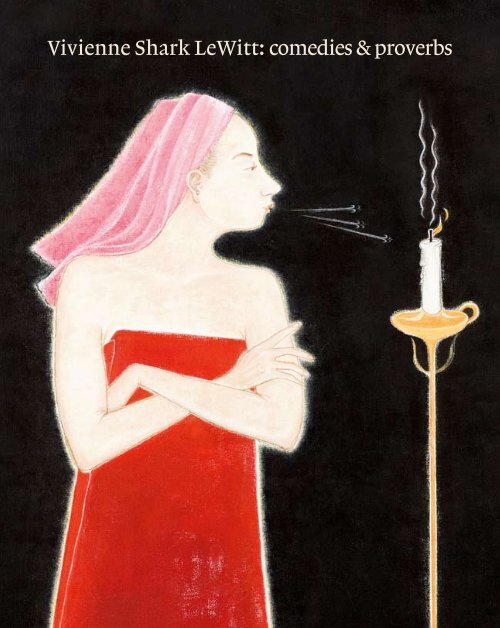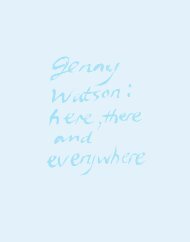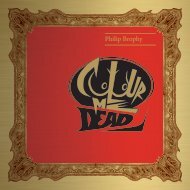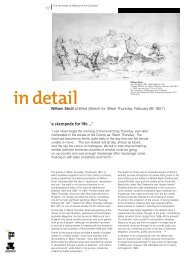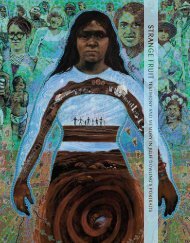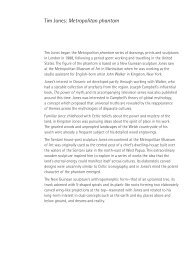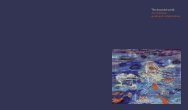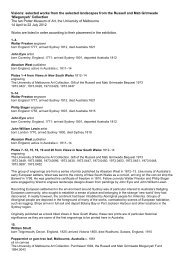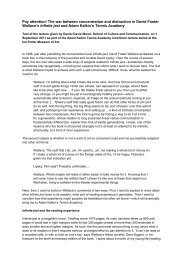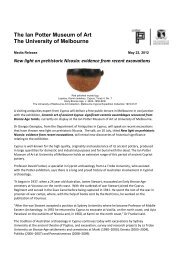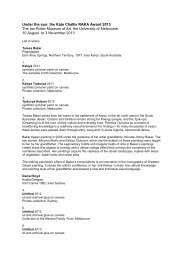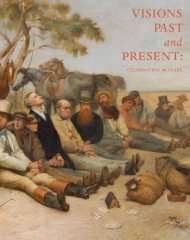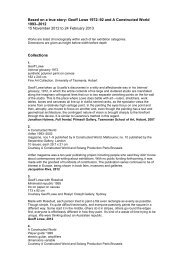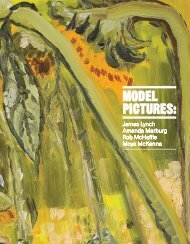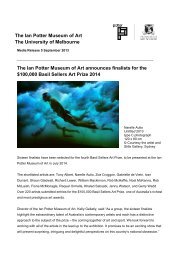Vivienne Shark LeWitt comedies & proverbs
Vivienne Shark LeWitt: comedies & proverbs - Ian Potter Museum of ...
Vivienne Shark LeWitt: comedies & proverbs - Ian Potter Museum of ...
Create successful ePaper yourself
Turn your PDF publications into a flip-book with our unique Google optimized e-Paper software.
<strong>Vivienne</strong> <strong>Shark</strong> <strong>LeWitt</strong>: <strong>comedies</strong> & <strong>proverbs</strong>
<strong>Vivienne</strong> <strong>Shark</strong> <strong>LeWitt</strong>: <strong>comedies</strong> and <strong>proverbs</strong><br />
3 Dr Chris McAuliffe Foreword<br />
4 Bala Starr Exotic, civilizing and in tune: the art of <strong>Vivienne</strong> <strong>Shark</strong> <strong>LeWitt</strong><br />
10 Helen McDonald The unbearable lightness of being in the paintings of <strong>Vivienne</strong> <strong>Shark</strong> <strong>LeWitt</strong><br />
47 <strong>Vivienne</strong> <strong>Shark</strong> <strong>LeWitt</strong>: biography and bibliography<br />
50 Catalogue of works in the exhibition
cat. 43<br />
Ask me anything 2003<br />
76.5 x 91.5 cm
Foreword<br />
In its original sense, the word ‘museum’ referred to the seven muses, mythical<br />
offspring of Zeus and Mnemosyne. Any space, domestic as well as public, dedicated<br />
to the pursuit of music, poetry and history could be dubbed a museum. <strong>Vivienne</strong><br />
<strong>Shark</strong> <strong>LeWitt</strong>’s art invokes the spirit of Thalia (comedy), Euterpe (music, lyric poetry),<br />
Melpomene (tragedy) and their sisters; even Urania (astronomy), the odd one out,<br />
because I can picture <strong>Shark</strong> <strong>LeWitt</strong> as a stargazer. The artist does not literally seek<br />
equivalences with literature and music but an art founded in subtle emotions almost<br />
inevitably invokes the time-honoured phrase Ut pictura poesis (As is painting, so is<br />
poetry). <strong>Vivienne</strong> <strong>Shark</strong> <strong>LeWitt</strong>’s sensibility offers an important counterbalance to our<br />
predominantly instrumental culture; it reminds us that an art based on sensibility is<br />
robust, rigorous and challenging.<br />
By disposition, I venerate Clio, the muse of history, above all others. <strong>Vivienne</strong> <strong>Shark</strong><br />
<strong>LeWitt</strong>: <strong>comedies</strong> & <strong>proverbs</strong> is an exhibition that allows not only a contemporary<br />
engagement with the artist’s oeuvre but also the rediscovery of Australian art’s recent<br />
past. There are moments of surprise; remembering just how risky it was to make<br />
small paintings in the 1980s. And there are moments of reflection; understanding<br />
how much an independent vision rests on persistence, on the artist diligently<br />
developing a sense of what it is she is after.<br />
The process of rediscovering the character of <strong>Shark</strong> <strong>LeWitt</strong>’s art began with<br />
rediscovering the paintings themselves. We are very grateful first and foremost to<br />
the artist, <strong>Vivienne</strong> <strong>Shark</strong> <strong>LeWitt</strong>; to her representatives, Anna Schwartz Gallery<br />
and Roslyn Oxley9 Gallery; and to the many public, private and corporate lenders<br />
across Australia who supported our curator’s research and who have generously<br />
lent cherished works to this exhibition. Special thanks are due to Helen McDonald,<br />
whose astute catalogue essay offers alluring insights into the artist’s work. We are<br />
grateful also to Arts Victoria, whose grant in support of this exhibition recognises the<br />
importance of engaging with an artist’s oeuvre in depth.<br />
Dr Chris McAuliffe<br />
Director, the Ian Potter Museum of Art<br />
3
Exotic, civilizing and in tune: the art of <strong>Vivienne</strong> <strong>Shark</strong> <strong>LeWitt</strong><br />
Bala Starr<br />
Curator, the Ian Potter Museum of Art<br />
Spanning a twenty-eight year painting practice, this<br />
exhibition is the first substantial display of <strong>Vivienne</strong> <strong>Shark</strong><br />
<strong>LeWitt</strong>’s art at an Australian museum. <strong>Shark</strong> <strong>LeWitt</strong> has<br />
lived and worked in Victoria since soon after completing<br />
post-graduate studies in Sydney in 1981, but more than<br />
a third of the fifty works selected for the exhibition have<br />
never been shown in Melbourne. After quickly gaining the<br />
attention of critics and curators in Australia and overseas<br />
as a young artist in the 1980s, <strong>Shark</strong> <strong>LeWitt</strong>’s career has<br />
developed in an unusual way. Her ambitions for her art and<br />
for her own creative processes are uniquely particular to her<br />
temperament, governed by what she describes as a ‘natural<br />
rhythm’ of creativity, rather than by the flux of external<br />
conditions. Similarly, this is a body of work that has been<br />
produced free of the influence of art-world vagaries and<br />
pressures; all the better to examine what is at the heart of her<br />
practice: the way feelings work, the way nature works, how<br />
relationships exist.<br />
cat. 7<br />
The making of Leopold 1984<br />
diptych: 29 x 58 cm,<br />
each: 29 x 29 cm<br />
4
Comedies & <strong>proverbs</strong>, installed over three gallery spaces, is<br />
an opportunity to reflect on <strong>Shark</strong> <strong>LeWitt</strong>’s art. Hers is an<br />
independent practice of making paintings in response<br />
to images that appear to her as translations of particular<br />
feelings or moments. This is the imagery of introspection,<br />
self-reflection and empathy for others. <strong>Shark</strong> <strong>LeWitt</strong><br />
communicates these closely held senses of human<br />
circumstance with unusual accuracy, a precision in part<br />
accountable to interpretative painterly methods that have<br />
remained inquisitive and open to experiment. Throughout<br />
the oeuvre, as a result of this exactitude, transactions<br />
between human and sometimes animal figures and their<br />
immediate world are rendered symbolic. The making of Leopold,<br />
a very early painting installed in the upstairs gallery is<br />
typically intoxicating in its obscurity. Flatly painted on two<br />
solid but tiny raw-edged wood panels, the work transgresses<br />
its diptych format with horizon lines and land masses that<br />
don’t meet or match. In a hot Mediterranean landscape,<br />
a stylishly outfitted couple, their hands and faces selfconsciously<br />
drawn, tender and endearing, are held together<br />
in an inexplicable altercation. The couple, their two-wheeler<br />
pram precariously positioned on the left-hand panel, and<br />
a slightly spooky black-sailed boat on the distant horizon<br />
above, could be unrelated were it not for the painting’s<br />
confined format. The male and female figures exchange<br />
flashing looks but their gestures are frozen. The scenery too<br />
appears disconnected: in parts dreamy in mottled orangebrown<br />
but also nakedly sectional. It is as though three or four<br />
portentous moments across time, across different centuries,<br />
have been brought together for re-telling in this painting;<br />
there are no superfluous elements.<br />
<strong>Shark</strong> <strong>LeWitt</strong> is not a prolific artist. Unlike many artists of her<br />
generation, her oeuvre is not marked by distinct phases or<br />
by repetition. As well, there are no discrete series that might<br />
offer a schematic framework for the selection process. Rather<br />
it is typical of the artist to move forward and backward<br />
to earlier motifs as well as re-form or evolve new images.<br />
Bearing this in mind, the exhibition has been distributed<br />
organisationally around four main thematic groupings<br />
that range across the oeuvre with the aim of offering a clear<br />
appreciation of the art’s pictorial and thematic developments.<br />
The first of these organisational groupings comprises the<br />
allegorical paintings of the 1980s; these are installed in the<br />
more intimate space of the upstairs gallery. The second<br />
grouping is ‘transactional/relational’ paintings, the third<br />
grouping includes paintings I think of as ‘negotiating the<br />
outside’, and the last comprises paintings showing a single<br />
female figure.<br />
The first allegorical group includes signature works of the<br />
period such as Last night I dreamed I went to Manderlay again<br />
(1985) and The omen, ‘That wascally wabbit’ (1987, held by<br />
the Art Gallery of New South Wales). These clearly show<br />
<strong>Shark</strong> <strong>LeWitt</strong>’s foundational ‘respect for the past, ancient<br />
to modern, the classic, the romantic, the Gothic, the<br />
symbolic, the iconic—in both culture and nature’. 1 These<br />
early paintings are also the most materially experimental or<br />
adventurous of the exhibition and include all but one of the<br />
eleven made on wood panels. Since 1987, <strong>Shark</strong> <strong>LeWitt</strong> has<br />
painted almost solely on canvas, increasing the scale of the<br />
work, but she still moves easily between oil and acrylic.<br />
In the first half of the 1980s, <strong>Vivienne</strong> <strong>Shark</strong> <strong>LeWitt</strong>, then in<br />
her mid-twenties, exhibited works in important Australian<br />
and international exhibitions including Bernice Murphy’s<br />
1983 Perspecta, Australian visions at the Solomon R Guggenheim<br />
Museum, New York, and Meaning & excellence, ANZART in<br />
Edinburgh (with Lyndal Jones, Howard Arkley, Robert Rooney,<br />
John Lethbridge, Linda Marrinon, Peter Tyndall and Geoff<br />
Lowe). The works exhibited in these exhibitions display both<br />
personal and theoretical interests and, as well as being of<br />
rougher means, are less romantic than the work that was to<br />
follow soon afterwards.<br />
<strong>Shark</strong> <strong>LeWitt</strong>’s close friend and champion, Paul Taylor’s<br />
selection of Charles Meryon the voyeur 1827–1868. La belle et<br />
la bête (1983) to headline his article ‘Civilization and its<br />
discontents’ in the January 1985 issue of Flash Art, confirms<br />
<strong>Shark</strong> <strong>LeWitt</strong>’s own sense that her work was ‘all very public<br />
from the beginning’. It’s worth noting that <strong>Shark</strong> <strong>LeWitt</strong>’s<br />
paintings of the time lacked one or more of the characteristics<br />
of ambitious scale, prolificacy or simple bravado we now<br />
assume to exist in the work of young art-school graduates<br />
that quickly enters the public domain—and it was not so<br />
different then. But more importantly, her success at the time<br />
was to do with the simple fact that the style and content of<br />
5
VIVI EN N E SHAR K LEWITT: com edi es & PROVER BS<br />
her work was a perfect fit for what was a Transavantgarde<br />
moment—this was confirmed as much by her inclusion in<br />
the 1986 Biennale of Sydney along with artists such as Mimmo<br />
Paladino, Gerard Garouste and Pierre Klossowski. Be this as<br />
it may, <strong>Shark</strong> <strong>LeWitt</strong>’s cover illustration for the winter 1984<br />
issue of Art & Text (published by Taylor two years after he<br />
had curated the landmark Popism exhibition) shows a young<br />
woman in profile, a redhead who has turned away from us<br />
with eyes closed, covering her mouth with her hand. It is a<br />
picture of withholding, reserve and of looking inward.<br />
Sensitive and compelling paintings such as the four-part<br />
Those who live in envy die in despair (1983) and Goodness always<br />
triumphs over evil (1984) became iconic for their time,<br />
personifying a critical shift in the established art hierarchy.<br />
<strong>Shark</strong> <strong>LeWitt</strong>’s work, always enigmatic, confounded public<br />
expectations of what ‘ambitious internationalist’ Australian<br />
art should be. Her small-scale supports link instead to the<br />
intimacy and privacy of the book, the pragmatism of tabletop<br />
as easel, and to ease of display in the home. In paintings<br />
such as Goodness always triumphs over evil and The bloody chamber<br />
(1983) she experimented with ways of representing the<br />
figure emblematically. Writers including Edward Colless<br />
and Judy Annear have described in detail <strong>Shark</strong> <strong>LeWitt</strong>’s<br />
early iconography in relation to fable, myth, metaphor and<br />
allegory. Increasingly, however, it is the particulars of a work’s<br />
prevailing sensibility or civility—its material surface, the<br />
colour and shape of a dress, the tilt of a woman’s head—that<br />
convey complex understandings and nuances of feeling, in<br />
turn calibrating the overall tone of a painting.<br />
<strong>Vivienne</strong> <strong>Shark</strong> <strong>LeWitt</strong>’s ‘French phase’ formally began in<br />
1987 when she began studying French daily at the University<br />
of Melbourne, but her seminars earlier with Meaghan<br />
Morris at Alexander Mackie College of Advanced Education<br />
in Sydney had already given her ‘an early and perfect<br />
introduction’ to semiotics and structuralism so that ‘the<br />
subsequent mania for French theory has never got the better<br />
of me’. 2 Another turning point occurred with the painting<br />
in 1987 of Shall I bark for you master? Or shall I bite? Ha, ha, ha,ha,<br />
the first time <strong>Shark</strong> <strong>LeWitt</strong>’s abiding respect for animals<br />
had entered the work so explicitly. The artist goes further in<br />
describing the idyllic autumn-hued Frankly I am lost, Brian of<br />
1988 as ‘an animal liberation painting’.<br />
The second, ‘transactional/relational’ grouping of works<br />
in the exhibition includes paintings where there is a<br />
contest between different psychological states shown in the<br />
relationship between two figures, where a ‘conversation’ or<br />
emotional exchange is at issue. These works are dispersed<br />
throughout each of the ground floor galleries. The grouping<br />
includes works from the late 1980s through to the present<br />
day, from Untitled and India song of 1988 (each showing<br />
a youthful figure in companionship with an animal), to<br />
paintings such as Prime movers (1994) and Spaghetti (1996) that<br />
depict power relations between a male and female.<br />
<strong>Shark</strong> <strong>LeWitt</strong>’s first solo exhibition in Melbourne was not<br />
held until 1991, when Georges Mora presented six riveting<br />
paintings at his Tolarno Galleries. Four of these paintings,<br />
SOB, Marvellous Melbourne, The lemon eater with bulldog attendant<br />
and $49.95, are included in the current exhibition, the latter<br />
three forming part of the second organisational grouping of<br />
works, those that I am describing as transactional. The male<br />
and female subjects of these paintings are more physically<br />
developed, their expressions more telling than those of<br />
earlier allegorical works. However, the increased intensity<br />
of gesture and tonality in these works is built across what<br />
are still very carefully moderated surfaces. Two of the four<br />
canvases present contemporary social encounters, linking<br />
them thematically to a number of more humorous paintings<br />
(and works on paper) that were to follow later in the 1990s.<br />
$49.95’s curvaceous Cruella de Vil in chic black at the cash<br />
register confronts a customer who wears the tweed suit <strong>Shark</strong><br />
<strong>LeWitt</strong> herself had always desired. The sale price of $49.95<br />
recalls her family’s in-joke about the apparent cost of all<br />
things advertised on television. Marvellous Melbourne is almost<br />
frightening in its depiction of a couple raucously openmouthed<br />
in rapture at their city’s glory, recalling something<br />
of the power of painted commentaries of 1950s Melbourne.<br />
All of the five paintings from the 1990–91 period included<br />
in the exhibition were produced following a complete break<br />
from painting in 1989, when <strong>Shark</strong> <strong>LeWitt</strong> held a full-time<br />
position teaching art history at Prahran College of Advanced<br />
Education, reading widely, thinking and talking about art<br />
rather than making it.<br />
6
cat. 17<br />
Shall I bark for you master? Or shall I bite? Ha, ha, ha, ha 1987<br />
81.3 x 65.9 cm<br />
7
VIVI EN N E SHAR K LEWITT: com edi es & PROVER BS<br />
Foolish fly 1990<br />
oil on canvas<br />
60.5 x 50.5 cm<br />
8
The third and smallest grouping of works explores the theme<br />
of ‘negotiating the outside’. It includes unusually animated<br />
paintings such as the sparkling white Disorientalism (2003),<br />
where a young female figure almost loses her hat as she<br />
misses the steps alighting from a plane. Her backpack, neatly<br />
pressed shorts and plimsolls indicate a traveller nevertheless<br />
well-prepared for a journey into the wide-open world; our<br />
empathy for the young woman has cause to extend into a<br />
sanguine type of hope for her future. There is something<br />
about works such as Disorientalism that takes us beyond<br />
modest optimism, almost to the point that they bestow a<br />
broader sense of fortune to a life’s work and illuminate the<br />
benefits of a gracious engagement ‘outside’ of oneself.<br />
The third grouping also includes Refreshed (1994) and Finished<br />
(2001), where female figures in restrained office attire are<br />
engaged in different stages of writing a manuscript or<br />
processing paperwork. They respectively express relaxed<br />
absorption in the job at hand and a sweet elation at having<br />
just completed a task. The site is the place of work, the office<br />
or study (or studio); the subject of each figure’s negotiation is<br />
the (unseen) text or discourse and, through this, the external<br />
world. Typewriter and out-tray become intermediaries<br />
between an internal world and a realised public realm, the<br />
realm of the exhibition and the book. Such social efficacy<br />
is not restricted of course to women or to ‘good deeds’ and<br />
might just as well include daily negotiations of reading, the<br />
home, or account-keeping for instance.<br />
The fourth and final thematic group of works are those that<br />
depict a lone female figure. These begin in the exhibition<br />
about 1990 with SOB and reoccur up until the present.<br />
They are not self-portraits as such, but nonetheless pursue<br />
a figurative intensity—a psychological potency—inspired<br />
in part by self-reflection or looking closely around oneself.<br />
It is as if the artist has pursued a thought, responded to a<br />
provocation or recalled a circumstance that she then seeks<br />
to take account of pictorially. Nat sulph (named for the<br />
homeopathic remedy for dizziness), 2003, takes its place<br />
among other works of the same group on the major wall of<br />
the largest downstairs gallery. Featuring a beautiful female<br />
figure blowing out a candle, it links closely back in time<br />
to the sole selected work we were unable to locate for this<br />
exhibition, the wonderful Foolish fly (1990). <strong>Shark</strong> <strong>LeWitt</strong><br />
states that Foolish fly was produced as ‘an image of what<br />
annoyance is’. It was the first painting produced after her<br />
year-long break from painting and carries quite a different<br />
sensation from works of the previous decade.<br />
Both Foolish fly and Nat sulph provide evidence of <strong>Shark</strong><br />
<strong>LeWitt</strong>’s special methods of conceptual production as well<br />
as her interest to explore in painting empathy and history<br />
to evoke different types of feelings: hard feelings, anxious<br />
feelings, middling feelings, light feelings. She uses the motif<br />
of soft focused light—candlelight in Nat sulph and a fire-fly’s<br />
natural glow in Foolish fly—to link across time; its effect is<br />
to inspire us to imagine a kind of foreverness beyond the<br />
familiar immediacy of social mores and relations. <strong>Shark</strong><br />
<strong>LeWitt</strong> also uses her personal history—her memories of her<br />
mother, of growing up with her sister, and of shared family<br />
humour—as a connective link to other eras and to better<br />
understand the conditions of a painting. What is important<br />
about <strong>Shark</strong> <strong>LeWitt</strong>’s work is its internal coherency for<br />
herself, and, through her, for us too. I greatly admire her<br />
sensibility and what her art shows us of how the world might<br />
be. <strong>Vivienne</strong> <strong>Shark</strong> <strong>LeWitt</strong> is an exceptional artist, and hers is<br />
not an excessive or exaggerated vision. This is an artist who is<br />
not afraid of the dark; she’s not afraid to blow the candle out.<br />
It’s quite OK out there.<br />
Notes<br />
1 <strong>Vivienne</strong> <strong>Shark</strong> <strong>LeWitt</strong>, ‘“The end of civilization. Part II: love among the ruins”. George Paton Gallery, 28 July – 26 August 1983’,<br />
in Helen Vivian (ed.), A work in progress: 30 years at the George Paton Gallery, Palgrave Macmillan, South Yarra, Vic., 2008.<br />
2 <strong>Vivienne</strong> <strong>Shark</strong> <strong>LeWitt</strong>, Artfan, no. 6, 1996–97, p. 7.<br />
9
The unbearable lightness of being in the paintings of <strong>Vivienne</strong> <strong>Shark</strong> <strong>LeWitt</strong><br />
Helen McDonald<br />
There is an inscrutability about <strong>Vivienne</strong> <strong>Shark</strong> <strong>LeWitt</strong>’s<br />
paintings. At first glance they seem two-dimensional; the<br />
early works are shaped like painted collages or cutouts and<br />
the later ones are linear and crisp. The whimsical comic vision<br />
of James Thurber comes to mind. He and other cartoonists<br />
established a unique style of humour in simple, figurative<br />
line drawings for The New Yorker in the 1940s and ’50s, sending<br />
up the domestic foibles of middle-class Americans. Closer<br />
inspection of <strong>Shark</strong> <strong>LeWitt</strong>’s paintings reveals signs of the<br />
third dimension; subtle tonal modeling hints at figurative<br />
mass, and fragments of linear perspective suggest spatial<br />
depth. Another layer of depth is evoked by references and<br />
allusions, which are peppered through the works. Beneath<br />
these visual illusions and tropes an esoteric form of drama<br />
takes place. Intelligence, memory, imagination, empathy and<br />
humour all play a part in this primary process of invention.<br />
<strong>Shark</strong> <strong>LeWitt</strong>’s process is especially exacting, driving ideas<br />
in eccentric directions, bringing pressure to bear on design,<br />
mediating representation and shifting the impact of a joke.<br />
It has the power to bewilder the spectator while prompting<br />
amusement and delight.<br />
Taking time to settle on the right motif or gesture, <strong>Shark</strong><br />
<strong>LeWitt</strong> disciplines her forms into precise and compact<br />
compositions. She draws on routine experiences (Haircut)<br />
and images from the history of art (St Tobias and the angel),<br />
literature (The game of love and chance and Last night, I dreamed<br />
I went to Manderlay again) and popular culture (Cease and<br />
desist). Although she does not appropriate these sources as a<br />
postmodern self-reflexive gesture, she sometimes calls upon<br />
them as a strategy to comment on political ideas and the<br />
status quo. 1 Addressing situations in life where complications<br />
arise, many of <strong>Shark</strong> <strong>LeWitt</strong>’s creative ventures function as<br />
means of working out the dynamics of a problem. Sometimes<br />
personalities clash ($49.95), accidents happen (Spaghetti),<br />
relationships founder (Dangerous acquaintances) and it is hard<br />
to calculate who is responsible. Humour and art-making<br />
are ways of hastening a resolution to these quasi-moral<br />
dilemmas, defusing tensions (Bloody hell), encapsulating an<br />
impulse (Foolish fly) or reducing an attitude to a moment of<br />
stillness, sometimes with only a glow, a breath or a flicker of<br />
elemental life (Nat sulph).<br />
In much of her work, especially from the 1990s, <strong>Shark</strong> <strong>LeWitt</strong><br />
draws on the witty remarks, sarcasm, caricature and jokes of<br />
everyday spontaneous exchanges, creating visual variants of<br />
them that are recognizably funny. She favours the immediacy<br />
of the popular cartoon more than the elevated and detached<br />
genres of satire and parody, although elements of the latter<br />
characterize aspects of her work. Her personae are prudently<br />
designed, nevertheless, and positioned in relation to others<br />
for specific effect. Described by some as a comedy of manners,<br />
her art lampoons familiar patterns of social behaviour<br />
and personality types, rather than particular individuals.<br />
Although sometimes sharp, her characterizations are<br />
generally empathetic. Images of people and companion<br />
animals in her art (India song, Hepaplex) offer a compassionate<br />
slant on attachments between pets and their owners. Pets<br />
are tenderly regarded by their masters or mistresses, whose<br />
expectations of subservience are, in turn, often cast back on<br />
themselves (The lemon eater with bulldog attendant and Shall I<br />
bark for you master? Or shall I bite? Ha, ha, ha, ha).<br />
The drama and sentiments conveyed by the figures or<br />
personae in <strong>Shark</strong> <strong>LeWitt</strong>’s paintings are not grand or<br />
extreme. Sentiment in her art is a mediated form of emotion,<br />
more a mood or state of mind than a passion. Simple delight<br />
in modest pleasures (Finished, Refreshed), the sense of being<br />
reduced to insignificance by another’s private obsessions<br />
(‘Me? Here?’) or of repressing embarrassment at a pointed<br />
question or proposition (Temperance and $49.95), are common,<br />
everyday experiences that we all recognize. As an avid<br />
student of human nature, <strong>Shark</strong> <strong>LeWitt</strong> has a sharp eye for<br />
self-delusion (The more fool I, so great a fool to adore and MAN)<br />
and the ridiculous (The egg and I and Teresa of Avila). She is<br />
capable of pungent caricature (Marvellous Melbourne), comical<br />
farce (Cease and desist), self-parody (Disorientalism) and gentle<br />
mockery (Prime movers).<br />
10
cat. 35<br />
Spaghetti 1996<br />
96.5 x 86 cm<br />
11
VIVI EN N E SHAR K LEWITT: com edi es & PROVER BS<br />
The title of the exhibition, Comedies & <strong>proverbs</strong>, is not strictly<br />
categorical or binding. Adages such as ‘goodness always<br />
triumphs over evil’ and ‘those who live in envy die in despair’<br />
illustrate traditional wisdom or practical advice about how<br />
to live one’s life. However the connection between title and<br />
content in <strong>Shark</strong> <strong>LeWitt</strong>’s works is not always apparent. The<br />
anachronistic moralizing of the old sayings sits oddly with<br />
modern art, raising the possibility of hidden meaning or<br />
irony. This incongruity is echoed in the style of the work. The<br />
title for Goodness always triumphs over evil (1984), for instance,<br />
was inspired by ‘the unknown Master of the Triumph of<br />
Death’, who painted the early fourteenth-century murals<br />
at the Camposanto in Pisa. But <strong>Shark</strong> <strong>LeWitt</strong> designed her<br />
work like a miniature Late Gothic wooden altar-piece. Three<br />
parts of a narrative are staged within mock gold-leaf pointedarch<br />
shaped frames, the middle one of which is divided into<br />
two panels, totaling four in all. The awkward, unfinished<br />
aspect of the painting’s manufacture, however, is entirely<br />
contemporary, with its slightly colliding panels splitting<br />
the central image down the middle, the use of mixed media,<br />
uneven brushwork, linear detailing, blocks of flat colour and<br />
lack of painterly modeling. The lateral figure-groupings in<br />
their half-arched frames are abruptly cut off by the edges<br />
of the wooden panel, suggesting that the narrative, too, is<br />
incomplete, or at least ongoing.<br />
Although the figure grouping resembles that of fourteenthcentury<br />
Italian painting, the principal personae in Goodness<br />
always triumphs over evil connote the romantic knights and<br />
damsels in medieval tales of chivalry, such as Ludovico<br />
Ariosto’s L’Orlando furioso, or the mysterious, pale-skinned<br />
classical lovers of nineteenth-century Symbolist painter<br />
Pierre Puvis de Chevannes. The two central figures, a kneeling<br />
woman in a white dress writing at a prayer-table and a man<br />
in black whose hands rest ambiguously on her shoulders,<br />
appear to be signing a contract, a marriage or engagement,<br />
perhaps, which is being celebrated or scrutinized on the left<br />
by a group of solemn onlookers dressed in twentieth-century<br />
clothes. A man in black appears in this lateral scene too,<br />
standing behind the others at a distance, with one hand to<br />
his face. Perhaps he is ostracized or hatching a plot of some<br />
kind. The narrative takes on a supernatural aspect as, from<br />
the scene on the right, a red man with devil’s horns walks<br />
out of the picture frame, raising his left hand enigmatically<br />
and glaring over his right shoulder at the man in black.<br />
Complementing each scene, the field surrounding the young<br />
couple grows lush and green, with a sprinkling of flowers,<br />
whereas the grass around the horned man turns brown. More<br />
like a figure from a Jean Cocteau movie than the Bible, this<br />
devil-man’s ominous presence is more psychological and<br />
cinematic than religious.<br />
Few clues to a private meaning manifest in Goodness always<br />
triumphs over evil. As with most open-ended visual narratives<br />
in contemporary art, the beholder is free to imagine his or<br />
her own interpretation. However while some contemporary<br />
artists relinquish all authorial control, <strong>Shark</strong> <strong>LeWitt</strong><br />
points out, when asked, that every detail of her art is there<br />
for deliberate reasons. She is drawn to the resonances of<br />
historical art and literature, and infuses her own work with<br />
a similar aura of history. The miniature size and antique<br />
appearance of her early works invest them with the mystery<br />
of a hidden text in which ancient secrets and old romantic<br />
scandals can be unraveled. Her use of cryptic painterly<br />
styles offers the thrill of discovering an outmoded school<br />
or the hand of an obscure artist, perhaps long forgotten.<br />
However, <strong>Shark</strong> <strong>LeWitt</strong>’s paintings contain more than simple<br />
references that evoke the past or produce affects. The horned<br />
man, who appears in Goodness always triumphs over evil, for<br />
instance, performs a function that suggests he represents an<br />
ambiguous moral conscience.<br />
This devil-figure first appeared in The look of love (1982) and<br />
secondly in Charles Meryon the voyeur 1827–1868. La belle et la<br />
bête (1983). Charles Meryon was in fact a nineteenth-century<br />
engraver who famously depicted the Notre Dame gargoyle,<br />
the cynical Le stryge (vampire or ghoul) who watches over<br />
Paris. The unfulfilled Meryon dreamed in vain of revisiting<br />
and eventually settling in New Zealand, where he had sailed<br />
as a younger man. <strong>Shark</strong> <strong>LeWitt</strong> casts Meryon, the artist<br />
himself, as the bored custodian of Parisian daily life. In her<br />
painted version of him, Meryon occupies the right panel in<br />
a diptych, folding his huge purple wings behind him as he<br />
rests his chin on his left hand. His right hand points a pistol<br />
at the woman in the adjoining panel as she carries a sword<br />
up a red path. The addition of the pistol is a twist on the<br />
traditional French fairytale of Beauty and the Beast. Meryon<br />
is the Beast, presumably, longing to be loved by innocent<br />
Beauty. Instead of the fairy-tale gentleman within a beast’s<br />
body, however, <strong>Shark</strong> <strong>LeWitt</strong>’s Meryon has become a sinister<br />
12
cat. 6<br />
Goodness always triumphs over evil 1984<br />
4 parts: 76 x 116 cm, each: 76 x 29 cm<br />
13
VIVI EN N E SHAR K LEWITT: com edi es & PROVER BS<br />
14
stalker. There is no apparent explanation for Meryon’s<br />
malicious intentions; it is as though he has a mind of his<br />
own. The idea of him taking a pot-shot at a figure in another<br />
painting, however, not only satirizes the painting’s original<br />
artistic sources, it also upsets the illusionistic function of<br />
painting itself. As the agent of such ideas, the capricious<br />
and judgmental Meryon registers the degree of creative and<br />
moral uncertainty that <strong>Shark</strong> <strong>LeWitt</strong> confronts in each work,<br />
as well as the wit and humour she brings to the process.<br />
Subtlety and nuance in <strong>Shark</strong> <strong>LeWitt</strong>’s works are never<br />
vague or accidental. Her later works, especially, are light but<br />
restrained in mood. The title and image of a recent work,<br />
Che va piano va sicuro; 2007, spell out this weightless, carefully<br />
tempered disposition. The title is an anglicized Italian<br />
expression that <strong>Shark</strong> <strong>LeWitt</strong> came across in a novel. Chi va<br />
piano va sicuro translates as he/she who goes slowly goes surely.<br />
With its inconclusive semi-colon, <strong>Shark</strong> <strong>LeWitt</strong>’s title chimes<br />
with the image, a sketchily painted landscape partly based<br />
on that marvelous monument to Roman imperial ambition<br />
and engineering, the Appian Way (c. 312 BCE). Stretching<br />
from Rome to Brindisi the ancient causeway is scattered with<br />
the remnants of entire suburbs, graveyards and fabulous<br />
mansions that have been subject to invasion and theft over<br />
many centuries. Nowadays, covered in grass and lined with<br />
cypress and pine trees, it is a living testament to the aesthetic<br />
of the ruin, the vanities of human civilization and the<br />
resilience of nature. <strong>Shark</strong> <strong>LeWitt</strong>’s landscape is painted in<br />
dry acrylics, featuring a couple of scratchy, dark, flat-topped<br />
umbrella pines that dominate the centre of the composition,<br />
and a soft country road that winds behind them as another<br />
forks off in front to the right up a slight hill. Behind the<br />
top of the hill the remains of a sandy-coloured brick wall<br />
or chimney rise, block-like, against the pale sky. Two small<br />
pencil cypresses punctuate the foreground, as a line of white<br />
flowers, like a wreath, brackets the right side of the picture<br />
plane. The elegant illustrational style, slightly muted colours<br />
and white surrounds of this economical scene are reminiscent<br />
of an old tinted postcard of the type one’s grandmother<br />
might have received from her soldier lover stationed in Italy<br />
during the Second World War.<br />
The conspicuous absence of people in Che va piano va sicuro; is<br />
significant. The artist’s own home of many years is nestled at<br />
the foot of a hill in the Victorian country town of Daylesford,<br />
far from the bustling metropolis of Melbourne. A road runs<br />
past her house to an old established garden of cypresses and<br />
pines, not unlike Che va piano va sicuro; or indeed the Appian<br />
Way. On weekends and public holidays, the otherwise peaceful<br />
bush-land retreat of Daylesford, once an important goldmining<br />
town and spa, is inundated with cars and visitors.<br />
It is a sad irony that even the individuality and obscurity<br />
of ruins and past civilizations, in their wilderness settings,<br />
are reduced to equivalence by cultural appropriation and<br />
the global tourist industry. There is a knowing resistance to<br />
exploitation in Che va piano va sicuro; however, which is hinted<br />
at by the forked road presenting a dilemma for the traveller,<br />
and the fact that both paths disappear in the middle-distance,<br />
one leading to a dense forest of trees and the other to the ruin.<br />
In a round about way the title, too, warns of danger, hinting<br />
that the Arcadian fantasy on offer might hide a darker reality.<br />
In this respect, Che va piano va sicuro; is more a philosophy of<br />
environmental care than a fairy-tale.<br />
The integration of form and concept in <strong>Shark</strong> <strong>LeWitt</strong>’s art,<br />
especially in the early work, may be partly an effect of her artschool<br />
training at sculpting in wood. For instance, Dangerous<br />
acquaintances, 1986, which is painted as an oval-shaped image<br />
on a small wooden panel, is divided into two complementary<br />
shapes that lock into one another, almost like the Chinese<br />
symbols of yin and yang (heaven and earth). Conceptually,<br />
yin and yang are antitheses in human perception, combining<br />
to form a unified whole. On the right-hand side of Dangerous<br />
acquaintances, the yang consists of a naked man in his arched<br />
frame reminiscent of Meryon in Goodness always triumphs over<br />
evil. He looks over his right shoulder as he tips water from a<br />
large pitcher onto a flailing woman. She and her surrounds<br />
constitute the yin. Her open mouth and outstretched arm<br />
and hand express the shock of having water dropped on one<br />
from a great height, a visual metaphor for an unexpected<br />
insult or cutting remark.<br />
cat. 48<br />
Che va piano va sicuro; 2007<br />
76 x 61 cm<br />
15
VIVI EN N E SHAR K LEWITT: com edi es & PROVER BS<br />
A later work, Bloody hell, 1994, shows a similarly playful<br />
complementariness of form and concept. <strong>Shark</strong> <strong>LeWitt</strong><br />
reinvents the tradition of headless ghosts, who speak from<br />
their severed heads, to graphically represent the idea of the<br />
mind/body split and the existence of the soul. Hence Bloody<br />
hell depicts a twentieth-century woman in an office-suit of<br />
no specific decade or style. She stands, practical and matterof-fact,<br />
her sensible flat shoes planted solidly on the viridian<br />
ground. Her upright body is materially very present except<br />
that she is carrying her annoyed-looking head under her arm,<br />
as though it were a portfolio containing essential details of<br />
identity. The diagrammatic line around the space that the<br />
head once occupied describes the absence of the missing<br />
head in office-speak. It also suggests an inner life or presence.<br />
As such, Bloody hell begs the question, in a gruesome but<br />
bloodless way, of whether we have a soul or mind and if so<br />
whether it lives in the head or the rest of the body.<br />
Most of <strong>Shark</strong> <strong>LeWitt</strong>’s central personae are women, and it is<br />
tempting to read feminist irony into some of the scenes she<br />
portrays. Reversing the roles in Titian’s Diana and Actaeon,<br />
1559, for instance, one might identify Actaeon as the man<br />
in Dangerous acquaintances, who punishes the goddess Diana<br />
for spying on him as he bathes nude. Similarly, in Bloody hell,<br />
the traditional idea that woman is body and man is mind is<br />
drastically unpicked. The woman in Goodness always triumphs<br />
over evil, perhaps doubling as the artist herself, might be<br />
writing a narrative for both the painting as well as her own<br />
life thereby defying patriarchal law. Although it is possible to<br />
infer these meanings from the many connotations in the art,<br />
however, <strong>Shark</strong> <strong>LeWitt</strong>’s focus is only obliquely political. In<br />
a similar vein, it might be argued that her paintings are not<br />
really jokes, even though they at first seem spontaneous and<br />
light-hearted. As already demonstrated, their humour and<br />
criticality derive from a reflective engagement with a variety<br />
of formal, artistic, social, environmental and intellectual<br />
sources.<br />
Many of these points of engagement are evident in my final<br />
example, Frankly I am lost, Brian (1988), an early landscape<br />
painted in sympathy with the tenets of Animal Liberation. 2<br />
It recalls René Magritte’s Le blanc-seing (1965) 3 , in which an<br />
upright woman in nineteenth-century garb steers her large<br />
horse through tall straight trees. <strong>Shark</strong> <strong>LeWitt</strong>’s trees are<br />
bare and planted in a single line across a path, slicing the<br />
autumn landscape into vertical segments. A man and woman<br />
riding bareback saunter from right to left across the stagelike<br />
foreground. Compared to Magritte’s ghostly mirage,<br />
<strong>Shark</strong> <strong>LeWitt</strong>’s couple on their alabaster toy-like horses are<br />
almost comical, more like an amateur-theatre version of a<br />
Gainsborough couple returning from the hunt. In <strong>Shark</strong><br />
<strong>LeWitt</strong>’s ‘non-hunting scene’ the young woman turns to look<br />
encouragingly at a hesitant dog who carries an unharmed<br />
pheasant on his back. Matching the empathetic tenor of<br />
this work, <strong>Shark</strong> <strong>LeWitt</strong>’s lightness of touch, translucent<br />
paintwork, meticulous design, refined temperaturecontrasting<br />
colour scheme and delicate atmospheric effects<br />
are vibrant testament to a sensitive, deeply thoughtful,<br />
authorial presence.<br />
Notes<br />
1 Peter Cripps, ‘<strong>Vivienne</strong> <strong>Shark</strong> <strong>LeWitt</strong>’, Interviews with artists, Institute of Modern Art, Brisbane, 1986, p. 14.<br />
2 Peter Singer, Animal liberation: A new ethics for our treatment of animals, New York Review/Random House, New York, 1975.<br />
3 René Magritte, Le blanc-seing, 1965, National Gallery of Art, Washington.<br />
16
cat. 18<br />
Frankly I am lost, Brian 1988<br />
50 x 60 cm<br />
17
18
cat. 3<br />
Charles Meryon the voyeur 1827–1868.<br />
La belle et la bête 1983<br />
diptych: dimensions variable,<br />
each: 36 x 30 cm (irreg.)<br />
cat. 2<br />
The bloody chamber 1983<br />
triptych: 37 x 57 cm (irreg.);<br />
a: 23 x 19 x 4.5 cm,<br />
b: 37 x 19 x 4.5 cm (irreg.),<br />
c: 23 x 19 x 4.5 cm<br />
19
cat. 5<br />
Those who live in envy die in despair 1983<br />
4 parts: 27.5 x 88.5 cm (irreg.);<br />
a: 27 x 19 cm, b: 24 x 25 cm,<br />
c: 24 x 25.5 cm, d: 27.5 x 19 cm<br />
20
21
cat. 12<br />
Dangerous acquaintances 1986<br />
25.5 x 15 cm<br />
22
cat. 8<br />
Last night, I dreamed I went to Manderlay again 1985<br />
26 x 29 cm<br />
23
cat. 16<br />
The omen, ‘That wascally wabbit’ 1987<br />
61 x 71 cm<br />
24
cat. 22<br />
$49.95 1990<br />
55 x 70.5 cm<br />
cat. 17<br />
Shall I bark for you master? Or shall I bite? Ha, ha, ha, ha 1987<br />
81.3 x 69.5 cm<br />
25
cat. 23<br />
The lemon eater with bulldog attendant 1990<br />
56 x 66 cm<br />
26
cat. 24<br />
SOB 1990<br />
61 x 45.7 cm<br />
27
cat. 26<br />
The more fool I, so great a fool to adore 1991<br />
36 x 26 cm<br />
28
29
30
cat. 27<br />
Haircut 1993<br />
81.5 x 81.5 cm<br />
cat. 30<br />
Prime movers 1994<br />
81.5 x 81.5 cm<br />
31
cat. 29<br />
Bloody hell 1994<br />
137 x 86 cm<br />
cat. 31<br />
Refreshed 1994<br />
137 x 112 cm<br />
32
33
cat. 37<br />
Hope (three coins in a fountain) 1998<br />
107 x 86 cm<br />
cat. 34<br />
The egg and I ( for Flora) 1996<br />
153 x 97 cm<br />
34
35
cat. 33<br />
Cat 1996<br />
81.5 x 81.5 cm<br />
36
cat. 36<br />
Faith (E = mc 2 ) 1998<br />
112 x 92 cm<br />
37
cat. 41<br />
Teresa of Avila 2001<br />
71 x 61 cm<br />
38
39
cat. 40<br />
Receipt 2001<br />
86 x 102 cm<br />
40
cat. 39<br />
Finished 2001<br />
81 x 92 cm<br />
41
cat. 44<br />
Disorientalism 2003<br />
97.5 x 81 cm<br />
42
cat. 46<br />
Nat sulph 2003<br />
112 x 97 cm<br />
43
cat. 45<br />
Hepaplex 2003<br />
92 x 76.5 cm<br />
44
45
cat. 47<br />
Cease and desist 2006<br />
77 x 67 cm<br />
The porcupine from Cautionary tales for children by Hilaire Belloc<br />
(© the estate of Hilaire Belloc 1896) is reproduced by permission<br />
of PFD on behalf of the estate of Hilaire Belloc
<strong>Vivienne</strong> <strong>Shark</strong> <strong>LeWitt</strong>: biography and bibliography<br />
Biography<br />
Born Sale, Victoria, 1956; lives Daylesford, Victoria<br />
Education<br />
1980–81 Post-graduate Diploma of Art, Alexander Mackie College of Advanced Education, Sydney<br />
1976–79 Diploma of Fine Arts, Tasmanian School of Art, Tasmanian College of Advanced Education, Hobart<br />
1974–75 The University of Adelaide<br />
Selected solo exhibitions<br />
2007 <strong>Vivienne</strong> <strong>Shark</strong> <strong>LeWitt</strong>: misc., Roslyn Oxley9 Gallery, Sydney<br />
2003 <strong>Vivienne</strong> <strong>Shark</strong> <strong>LeWitt</strong>: disorientalism, Anna Schwartz Gallery, Melbourne<br />
2001 <strong>Vivienne</strong> <strong>Shark</strong> <strong>LeWitt</strong>: pardon my sarong, Roslyn Oxley9 Gallery, Sydney<br />
1998 <strong>Vivienne</strong> <strong>Shark</strong> <strong>LeWitt</strong>: sorority virtues, Anna Schwartz Gallery at the Sixth Australian Contemporary Art Fair, Melbourne<br />
1997 <strong>Vivienne</strong> <strong>Shark</strong> <strong>LeWitt</strong>: works on paper, Anna Schwartz Gallery, Melbourne<br />
1996 <strong>Vivienne</strong> <strong>Shark</strong> <strong>LeWitt</strong>: the egg & I, Anna Schwartz Gallery, Melbourne<br />
1995 <strong>Vivienne</strong> <strong>Shark</strong> <strong>LeWitt</strong>, Roslyn Oxley9 Gallery, Sydney<br />
1994 <strong>Vivienne</strong> <strong>Shark</strong> <strong>LeWitt</strong>, Anna Schwartz Gallery, Melbourne<br />
<strong>Vivienne</strong> <strong>Shark</strong> <strong>LeWitt</strong>: works on paper, Roslyn Oxley9 Gallery, Sydney<br />
1992 <strong>Vivienne</strong> <strong>Shark</strong> <strong>LeWitt</strong>, Roslyn Oxley9 Gallery, Sydney<br />
1991 <strong>Vivienne</strong> <strong>Shark</strong> <strong>LeWitt</strong>: paintings, Tolarno Galleries, Melbourne<br />
1987 <strong>Vivienne</strong> <strong>Shark</strong> <strong>LeWitt</strong>, Roslyn Oxley9 Gallery, Sydney<br />
1986 <strong>Vivienne</strong> <strong>Shark</strong> <strong>LeWitt</strong>: paintings 1985/86, Institute of Modern Art, Brisbane<br />
1985 <strong>Vivienne</strong> <strong>Shark</strong> <strong>LeWitt</strong>: paintings, Roslyn Oxley9 Gallery, Sydney<br />
1984 <strong>Vivienne</strong> <strong>Shark</strong> <strong>LeWitt</strong>, Roslyn Oxley9 Gallery, Sydney<br />
Selected group exhibitions<br />
2008 Who let the dogs out: The dog in contemporary Australian art, Lake Macquarie City Art Gallery, New South Wales<br />
2004 The decadence of the nude, Ocular Lab, Melbourne<br />
Penetralia: Art and psychoanalysis in Melbourne, 1940–2004, RMIT Gallery, Melbourne<br />
2003 Curiosity kills the gap, Artspace, Auckland, New Zealand<br />
MCA unpacked II: six Australian artists select from the MCA Collection, Museum of Contemporary Art, Sydney<br />
See here now: Vizard Foundation Art Collection of the 1990s, the Ian Potter Museum of Art, the University of Melbourne<br />
2002 It’s a beautiful day: new painting in Australia: 2, the Ian Potter Museum of Art, the University of Melbourne, and Art Gallery of New South Wales, Sydney<br />
1999 Signs of life: Melbourne international biennial, 118 Russell Street, Melbourne<br />
Spellbound, Karyn Lovegrove Gallery, Los Angeles<br />
Take my wife, 1st Floor Artists’ and Writers’ Space, Melbourne<br />
1998 Cartoons and caricature in contemporary art, Geelong Gallery, Victoria<br />
1996 Imagining the real: an exhibition of recent acquisitions from the Parliament House Art Collection, Parliament House, Canberra<br />
Lovers, Museum of Modern Art at Heide, Melbourne<br />
1995 Double vision: artists’ portraits of artists, Ivan Dougherty Gallery, the University of New South Wales, Sydney<br />
The Loti and Victor Smorgon Collection of Contemporary Australian Art, Museum of Contemporary Art, Sydney<br />
1994 The John McCaughey Memorial Art Prize, National Gallery of Victoria, Melbourne<br />
1992 The nude 1992: Sara Weis Award, Heide Park and Art Gallery, Melbourne<br />
1991 National Australia Bank Collection: rivers in Australian art, Heide Park and Art Gallery, Melbourne<br />
1989 Aus Australien Print Portfolio, National Gallery of Victoria, Melbourne<br />
1988 From the Southern Cross: 7th biennale of Sydney, Art Gallery of New South Wales, Sydney<br />
History, Institute of Modern Art, Brisbane<br />
1987 The Australian Bicentennial perspecta, Art Gallery of New South Wales, Sydney (and tour to the Art Gallery of Western Australia, Perth;<br />
Frankfurter Kunstverein, Germany; and Württembergischer Kunstverein, Stuttgart, Germany)<br />
The golden shibboleth, 200 Gertrude Street, Melbourne<br />
Ormond College welcomes new art, Ormond College, the University of Melbourne<br />
The shadow of reason, Institute of Modern Art, Brisbane<br />
Young Australians, the Budget Collection, National Gallery of Victoria, Melbourne<br />
1986 The gothic: perversity and its pleasure, Institute of Modern Art, Brisbane (and tour to 200 Gertrude Street, Melbourne, and Chameleon Gallery, Hobart)<br />
Origins, originality + beyond: 6th biennale of Sydney, Art Gallery of New South Wales, Sydney<br />
Primal painting, Heide Park and Art Gallery, Melbourne<br />
1985 Close remarks, Artspace, Sydney<br />
Image codes, Australian Centre for Contemporary Art, Melbourne<br />
Return to sender: Donna Marcus, Loretta Quinn, <strong>Vivienne</strong> <strong>Shark</strong> <strong>LeWitt</strong>, Tasmanian School of Art Gallery, University of Tasmania, Hobart<br />
Visual tension, Australian Centre for Contemporary Art, Melbourne<br />
1984 Australian visions: 1984 Exxon international exhibition, Solomon R Guggenheim Museum, New York<br />
47
Meaning & excellence: ANZART in Edinburgh, Edinburgh College of Art, Scotland<br />
1983 Australian perspecta, Art Gallery of New South Wales, Sydney<br />
D’un autre continent l’Australie: le rêve et le réel, Musée d’Art Moderne de la Ville de Paris, France<br />
The end of civilization. Part II: love among the ruins (curated by the artist), George Paton Gallery, Melbourne<br />
Pirates and mutineers, Roslyn Oxley9 Gallery, Sydney<br />
1982 New painting, Roslyn Oxley9 Gallery, Sydney<br />
1978 Artists’ books/bookworks, Experimental Art Foundation, Adelaide; and Franklin Furnace, New York<br />
Grants<br />
1996 Visual Arts/Craft Board, Australia Council<br />
1983 Visual Arts Board, Australia Council<br />
Collections<br />
Art Gallery of New South Wales, Sydney<br />
City of Port Phillip, Melbourne<br />
Cruthers Collection of Women’s Art, the University of Western Australia, Perth<br />
Geelong Gallery, Victoria<br />
Museum of Contemporary Art, Sydney<br />
National Australia Bank, Melbourne<br />
National Gallery of Australia, Canberra<br />
National Gallery of Victoria, Melbourne<br />
Parliament House, Canberra<br />
Royal Automobile Club of Victoria (RACV) Limited, Melbourne<br />
Solomon R Guggenheim Museum, New York<br />
The University of Melbourne<br />
The University of Queensland<br />
Vizard Foundation Art Collection of the 1990s, on loan to the Ian Potter Museum of Art, the University of Melbourne<br />
Bibliography<br />
Books<br />
Bond, A & W Tunnicliffe (eds), Contemporary: Art Gallery of New South Wales: the contemporary collection, Art Gallery of New South Wales, Sydney, 2006, p. 238.<br />
Bonito Oliva, A (ed.), Trans-avantgarde international, Giancarlo Politi Editore, Milan, 1982, p. 275.<br />
Chanin, E (ed.), Contemporary Australian painting, Craftsman House, Roseville, NSW, 1990.<br />
Colless, T, ‘Love’s limbo: <strong>Vivienne</strong> <strong>Shark</strong> <strong>LeWitt</strong>’, The error of my ways, Institute of Modern Art, Fortitude Valley, Qld, 1995, pp. 155–60.<br />
Cripps, P, Interviews with artists, Institute of Modern Art, Brisbane, 1986, pp. 14–17.<br />
Fink, H, ‘<strong>Vivienne</strong> <strong>Shark</strong> <strong>LeWitt</strong>’, in C McAuliffe (ed.), See here now: Vizard Foundation Art Collection of the 1990s, Thames & Hudson (Australia), Fishermens Bend,<br />
Vic., in assoc. with the Ian Potter Museum of Art & the Vizard Foundation, Melbourne, 2003, pp. 126–7.<br />
McAuliffe, C, ‘The postmodern suburb’, Art and suburbia, Craftsman House, Roseville, NSW, pp. 115–16.<br />
McCulloch, A, S McCulloch & E McCulloch Childs (eds), The new McCulloch’s encyclopaedia of Australian art, Aus Art Editions in assoc. with Miegunyah Press,<br />
Fitzroy, Vic., 2006, pp. 634–5.<br />
Williams, D & C Simpson, Art now: contemporary art post 1970, McGraw-Hill, Sydney, 1994, pp. 193–4 & 215.<br />
Exhibition catalogues<br />
Armstrong, B, ‘Why birds?’, MCA unpacked II: six Australian artists select from the MCA Collection, Museum of Contemporary Art, Sydney, 2003.<br />
Burns, K, ‘The return of the nude’, The decadence of the nude, Melbourne, 2004.<br />
Cass, N, <strong>Vivienne</strong> <strong>Shark</strong> <strong>LeWitt</strong>, Roslyn Oxley9 Gallery, Paddington, NSW, 1995.<br />
Clabburn, A, ‘Whimsy in the white cube’, Cartoons and caricature in contemporary art, Geelong Gallery, Vic., 1998.<br />
Cramer, S, History, Institute of Modern Art, Brisbane, 1988.<br />
Engberg, J, ‘Love tokens’, Lovers, Museum of Modern Art at Heide, Bulleen, Vic., 1996.<br />
—— ‘<strong>Vivienne</strong> <strong>Shark</strong> <strong>LeWitt</strong>’, Signs of life: Melbourne international biennial, City of Melbourne, 1999, pp. 32 & 232.<br />
Hart, D, Imagining the real: an exhibition of recent acquisitions from the Parliament House Art Collection, Joint House Department, Parliament House, Canberra, 1996.<br />
Holloway, M, ‘Bleak romantics’, & D Waldman, ‘Impressions of Australia’, in Australian visions: 1984 Exxon International Exhibition, Solomon R Guggenheim<br />
Museum, New York, 1984.<br />
Holmes, J, Return to sender: Donna Marcus, Loretta Quinn, <strong>Vivienne</strong> <strong>Shark</strong> <strong>LeWitt</strong>, Tasmanian School of Art Gallery, University of Tasmania, Hobart, 1985.<br />
Lindsay, R, Young Australians: the best of young Australia, National Gallery of Victoria, Melbourne, 1987.<br />
—— ‘<strong>Vivienne</strong> <strong>Shark</strong> <strong>LeWitt</strong>’, ICI Contemporary Art Collection, ICI Australia, Melbourne, 1989, pp. 78–9.<br />
McKenzie, R, The Australian Bicentennial perspecta, Art Gallery of New South Wales, Sydney, 1987, pp. 101–17.<br />
—— <strong>Vivienne</strong> <strong>Shark</strong> <strong>LeWitt</strong>: works on paper, Roslyn Oxley9 Gallery, Paddington, NSW, 1994.<br />
Robinson, D, ‘Meaning & excellence’, Australian and New Zealand artists in Edinburgh, Richard Demarco Gallery, Edinburgh, 1984.<br />
Sophia, O, <strong>Vivienne</strong> <strong>Shark</strong> <strong>LeWitt</strong>: misc., Roslyn Oxley9 Gallery, Paddington, NSW, 2007.<br />
Starr, B, ‘New orbits in Australian painting’, It’s a beautiful day: new painting in Australia: 2, Art Gallery of New South Wales, Sydney, 2002, pp. 7–10, 14–15 & 37.<br />
Waterlow, N, Origins, originality + beyond: 6th biennale of Sydney, Art Gallery of New South Wales, Sydney, 1986.<br />
——From the Southern Cross: 7th biennale of Sydney, Art Gallery of New South Wales, Sydney, 1988.<br />
48
Journal and magazine articles and reviews<br />
Annear, J, ‘The allegory of <strong>Vivienne</strong> <strong>Shark</strong> <strong>LeWitt</strong>’, On the Beach, no. 5, 1984, pp. 33–5.<br />
—— ‘Us in the US’, Vogue Australia, August 1984, pp. 160–3.<br />
Barden, R, ‘The end of civilization’, Tension, no. 2, 1983, p. 5.<br />
—— ‘Love and fear: <strong>Vivienne</strong> <strong>Shark</strong> <strong>LeWitt</strong>’, Tension, no. 6, 1985, pp. 27–9.<br />
Burke, J, ‘Penetralia: art and psychoanalysis in Melbourne 1940–2004’, Art Monthly, September 2004.<br />
Colless, E, ‘Love’s limbo: paintings of <strong>Vivienne</strong> <strong>Shark</strong> <strong>LeWitt</strong>’, Art & Text, no. 29, 1988, pp. 30–9.<br />
Engberg, J, ‘<strong>Vivienne</strong> <strong>Shark</strong> <strong>LeWitt</strong>’, Art & Text, no. 58, 1997, p. 90.<br />
Frost, A, ‘It’s a beautiful day: new painting in Australia: 2’, Australian Art Collector, no. 23, 2003, p. 97.<br />
Gaynor, A, ‘The decadence of the nude’, un magazine, no. 1, 2004, pp. 21–2.<br />
Holloway, M, ‘Art attack’, Harpers Bazaar Australia, September 1984, p. 106.<br />
Kuspit, DB, ‘“Australian visions” at the Guggenheim’, Art in America, March 1985.<br />
Lumby, C & D Messer, ‘<strong>Vivienne</strong> <strong>Shark</strong> <strong>LeWitt</strong>: personal icons’, Follow Me, December–January 1987, p. 134–7.<br />
McKenzie, R, ‘What girls like’, Art & Text, no. 46, 1993, p. 66–73.<br />
—— ‘Comedies & <strong>proverbs</strong>’, Heat: luminous gerberas, Giramondo Publishing Company, Artarmon, NSW, no. 15, 2007, pp. 129–44.<br />
Murphy, B, ‘Recent painting in Australia’, Flash Art, January 1983, pp. 56–9.<br />
Pennings, M, ‘<strong>Vivienne</strong> <strong>Shark</strong> <strong>LeWitt</strong>’, Agenda, no. 17, 1991, p. 30.<br />
Simons, P, ‘6th biennale of Sydney’, The Burlington Magazine, vol. 128, no. 1001, 1986, pp. 630–1.<br />
Sullivan, E, ‘Wit as diversion/subversion’, Art Monthly, August 1992, pp. 17–19.<br />
Taylor, P, ‘Australian new wave and the second degree’, Art & Text, no. 1, 1981, p. 23.<br />
—— ‘Civilization and its discontents’, Flash Art, January 1985, pp. 67–9.<br />
Watson, J, ‘Urgent images’, Art & Text, no. 14, 1984, p. 69.<br />
Newspaper articles and reviews<br />
Adams, B, ‘Melbourne art keeps its cool’, The Sydney Morning Herald, 30 May 1987, p. 49.<br />
Crawford, A, ‘Reorientating the artist’, The Age, 20 September 2003, p. 7.<br />
Hill, P, ‘What seems soufflé-light is actually a slow roast of new-age men and women’, The Sydney Morning Herald, 18 October 2001, p. 20.<br />
—— ‘You beauty!’, The Sydney Morning Herald, 22–23 November 2002, p. 26.<br />
Fenner, F, ‘<strong>Vivienne</strong> <strong>Shark</strong> <strong>LeWitt</strong> and Tony Clark, Roslyn Oxley9 Gallery’, The Sydney Morning Herald, 30 June 1995.<br />
France, C, ‘Display with designs on the viewer’, The Weekend Australian, 18–19 July 1992, p. 13.<br />
Maloon, T, ‘<strong>LeWitt</strong> and Arkley show why young artists still dare to be different’, The Sydney Morning Herald, 12 May 1984, p. 46.<br />
McGrath, S, ‘Wood you believe?’, The Australian, 5–6 June 1982, p. 15.<br />
McKenzie, R, ‘Momentary lapses into nostalgia’, The Age, 8 May 1996.<br />
Nelson, R, ‘In theory, repressed. “Penetralia”’, The Age, 28 July 2004, p. 9.<br />
Raynor, V, ‘Art: capturing essence of a remote Australia’, The New York Times, 5 October 1984, p. C28.<br />
Rooney, R, ‘An unguided tour of love among the ruins’, The Australian, 24 August 1983, p. 50.<br />
—— ‘Obscured by a heart of semi-darkness: the John McCaughey Memorial Art Prize’, The Weekend Australian, 5–6 March 1994, p. 13.<br />
Writing by the artist and commissioned artwork<br />
<strong>Shark</strong> <strong>LeWitt</strong>, V, ‘So this is real life? The continuing dissensions of New Wave music’, The Tasmanian Review, no. 1, 1979, pp. 11–13.<br />
—— ‘Why Egyptian mods didn’t bother to bleach their hair or More notes about parkas and combs’, Art & Text, no. 3, 1981, pp. 80–6.<br />
—— ‘The end of civilization. Part II: love among the ruins’, Art & Text, winter, 1983, pp. 1–6.<br />
—— ‘Tattslotto’, Stuff, February 1983.<br />
—— ‘In the desert’, Stuff, August 1983.<br />
—— cover illustration, Art & Text, no. 14, 1984.<br />
—— Other people, Australian Centre for Contemporary Art, Melbourne, 1985.<br />
—— artwork, Kerb Your Dog, no. 4, 1988; no. 7, 1990; & no. 12, 1992.<br />
—— illustration, Pataphysics, no. F, 1990.<br />
—— ‘Paul Taylor 1957–1992’, Art & Text, no. 44, 1993, p. 14.<br />
—— ‘Exactly.’, 200 Gertrude Street, Fitzroy, Vic., 1996.<br />
—— illustration, Like, Art Magazine, no. 1, 1996, pp. 1 & 3.<br />
—— Artfan, no. 6, 1996–97, p. 7.<br />
—— illustration, Like, Art Magazine, no. 2, 1997, p. 3.<br />
—— illustration, Like, Art Magazine, no. 3, 1997, p. 3.<br />
—— poster design, Opera Theatre Company of Ireland, Melbourne International Festival of the Arts, 1997.<br />
——<strong>Vivienne</strong> <strong>Shark</strong> <strong>LeWitt</strong>: sorority virtues, Anna Schwartz Gallery, Melbourne, 1998.<br />
—— Caroline Williams: viva Australia: out of my mind, Robert Lindsay Gallery, Melbourne, 2000.<br />
—— ‘Mystic spiral 3: process’, Like, Art Magazine, no. 13, 2000, p. 2.<br />
<strong>Vivienne</strong> <strong>Shark</strong> <strong>LeWitt</strong> is represented<br />
by Anna Schwartz Gallery, Melbourne, and<br />
Roslyn Oxley9 Gallery, Sydney<br />
49
Catalogue of works in the exhibition<br />
Dimensions are given<br />
as height before width<br />
1 The look of love 1982<br />
synthetic polymer paint on canvas<br />
30.5 x 30.5 cm<br />
Collection of the artist<br />
2 The bloody chamber 1983<br />
synthetic polymer paint on wood<br />
triptych: 37 x 57 cm (irreg.); a: 23 x 19 x 4.5 cm,<br />
b: 37 x 19 x 4.5 cm (irreg.), c: 23 x 19 x 4.5 cm<br />
The University of Melbourne Art Collection. Purchased 1984<br />
3 Charles Meryon the voyeur 1827–1868.<br />
La belle et la bête 1983<br />
synthetic polymer paint on wood<br />
diptych: dimensions variable, each: 36 x 30 cm (irreg.)<br />
Private collection, Sydney<br />
4 China boy in the desert. The dead girl 1983<br />
synthetic polymer paint and gold leaf on wood<br />
diptych: 29 x 57 cm, each: 29 x 28.5 cm<br />
Collection of Naomi Cass, Melbourne<br />
5 Those who live in envy die in despair 1983<br />
synthetic polymer paint on wood<br />
4 parts: 27.5 x 88.5 cm (irreg.); a: 27 x 19 cm,<br />
b: 24 x 25 cm, c: 24 x 25.5 cm, d: 27.5 x 19 cm<br />
Private collection, Sydney<br />
6 Goodness always triumphs over evil 1984<br />
oil, synthetic polymer paint and gold leaf on wood<br />
4 parts: 76 x 116 cm, each: 76 x 29 cm<br />
Collection of Janice and Greg Taylor, Melbourne<br />
7 The making of Leopold 1984<br />
synthetic polymer paint on wood<br />
diptych: 29 x 58 cm, each: 29 x 29 cm<br />
Collection of the artist<br />
8 Last night, I dreamed I went to Manderlay again 1985<br />
oil and gold leaf on wood<br />
26 x 29 cm<br />
Collection of the artist<br />
9 Nightmare abbey 1985<br />
oil on wood<br />
22 x 15 cm<br />
Private collection, Sicily<br />
10 St Tobias and the angel 1985<br />
oil on canvas<br />
3 parts: dimensions variable;<br />
a: 56 x 70.5 cm, b: 27 x 18.5 cm, c: 27 x 18.5 cm<br />
Private collection, courtesy Roslyn Oxley9 Gallery, Sydney<br />
11 Zugzwang 1985<br />
oil on canvas<br />
36 x 29 cm (irreg.)<br />
Museum of Contemporary Art, Sydney<br />
Gift of Loti and Victor Smorgon, 1995<br />
12 Dangerous acquaintances 1986<br />
oil on wood<br />
25.5 x 15 cm<br />
Collection of the artist<br />
13 Frith 1986<br />
oil on wood<br />
38.3 x 33.5 cm<br />
National Gallery of Australia, Canberra<br />
Gift of the Philip Morris Arts Grant 1988<br />
14 The game of love and chance 1986<br />
oil on canvas<br />
91 x 122 cm<br />
Private collection, Melbourne<br />
15 Untitled (Bicentennial arts) 1986–87<br />
oil on canvas<br />
61 x 45.7 cm<br />
National Gallery of Victoria, Melbourne. Presented through the<br />
Art Foundation of Victoria by ICI Australia Limited, Fellow 1995<br />
16 The omen, ‘That wascally wabbit’ 1987<br />
oil on canvas<br />
61 x 71 cm<br />
Art Gallery of New South Wales, Sydney. Purchased 1988<br />
17 Shall I bark for you master? Or shall I bite? Ha, ha, ha, ha 1987<br />
oil on canvas<br />
81.3 x 65.9 cm<br />
Museum of Contemporary Art, Sydney. Purchased 1990<br />
18 Frankly I am lost, Brian 1988<br />
oil on canvas<br />
50 x 60 cm<br />
Baillieu Myer Collection of the ’80s, Melbourne<br />
19 India song 1988<br />
oil on canvas<br />
56 x 40.5 cm<br />
Collection of Justin and Sandra Shmith, Melbourne<br />
20 P & O 1988<br />
oil on canvas<br />
35 x 25 cm<br />
Collection of Roslyn and Tony Oxley, Sydney<br />
21 Untitled 1988<br />
oil on canvas<br />
45.7 x 55.8 cm<br />
Laverty Collection, Sydney<br />
22 $49.95 1990<br />
oil on canvas<br />
55 x 70.5 cm<br />
Private collection, Sydney<br />
23 The lemon eater with bulldog attendant 1990<br />
oil on canvas<br />
56 x 66 cm<br />
Private collection, Melbourne<br />
50
24 SOB 1990<br />
oil on canvas<br />
61 x 45.7 cm<br />
Private collection, Melbourne<br />
25 Marvellous Melbourne 1991<br />
oil on canvas<br />
45.7 x 61 cm<br />
Hyphema Collection, Perth<br />
26 The more fool I, so great a fool to adore 1991<br />
oil on wood<br />
36 x 26 cm (oval)<br />
National Australia Bank Art Collection, Melbourne<br />
27 Haircut 1993<br />
oil on canvas<br />
81.5 x 81.5 cm<br />
Cruthers Collection of Women’s Art, the University of Western Australia,<br />
Perth<br />
28 As they say 1994<br />
oil on canvas<br />
81.5 x 81.5 cm<br />
Parliament House Art Collection, Department of Parliamentary<br />
Services, Canberra<br />
29 Bloody hell 1994<br />
oil on canvas<br />
137 x 86 cm<br />
Vizard Foundation Art Collection of the 1990s, purchased 1994<br />
On loan to the Ian Potter Museum of Art, the University of Melbourne<br />
30 Prime movers 1994<br />
oil on canvas<br />
81.5 x 81.5 cm<br />
Collection of Susan Clements, Perth<br />
31 Refreshed 1994<br />
oil on canvas<br />
137 x 112 cm<br />
Collection of Kalli and Brian Rolfe, Melbourne<br />
32 MAN (7.30 pm) 1995<br />
oil on canvas<br />
137 x 86 cm<br />
Hyphema Collection, Perth<br />
33 Cat 1996<br />
oil on canvas<br />
81.5 x 81.5 cm<br />
Collection of David Loh and Lynne Boyce, Sydney<br />
34 The egg and I ( for Flora) 1996<br />
oil on canvas<br />
153 x 97 cm<br />
Geelong Gallery, Victoria. Purchased 1996<br />
35 Spaghetti 1996<br />
oil on canvas<br />
96.5 x 86 cm<br />
Private collection, Melbourne<br />
36 Faith (E = mc 2 ) 1998<br />
oil on canvas<br />
112 x 92 cm<br />
Private collection, Melbourne<br />
37 Hope (three coins in a fountain) 1998<br />
oil on canvas<br />
107 x 86 cm<br />
Private collection, Melbourne<br />
38 Temperance (now take you for instance) 1998<br />
oil on canvas<br />
112 x 92 cm<br />
Courtesy the artist and Anna Schwartz Gallery, Melbourne<br />
39 Finished 2001<br />
oil on canvas<br />
81 x 92 cm<br />
Janet and Michael Buxton Collection, Melbourne<br />
40 Receipt 2001<br />
oil on canvas<br />
86 x 102 cm<br />
Janet and Michael Buxton Collection, Melbourne<br />
41 Teresa of Avila 2001<br />
oil on canvas<br />
71 x 61 cm<br />
Collection of Elaine Baker and John Cruthers, Sydney<br />
42 ‘Me? Here?’ 2002<br />
oil on canvas<br />
107 x 77 cm<br />
Janet and Michael Buxton Collection, Melbourne<br />
43 Ask me anything 2003<br />
synthetic polymer paint on canvas<br />
76.5 x 91.5 cm<br />
Private collection, Melbourne<br />
44 Disorientalism 2003<br />
synthetic polymer paint on canvas<br />
97.5 x 81 cm<br />
Royal Automobile Club of Victoria (RACV) Limited Art Collection,<br />
Melbourne<br />
45 Hepaplex 2003<br />
oil and synthetic polymer paint on canvas<br />
92 x 76.5 cm<br />
Collection of Anna and Morry Schwartz, Melbourne<br />
46 Nat sulph 2003<br />
synthetic polymer paint on canvas<br />
112 x 97 cm<br />
Private collection, Melbourne<br />
47 Cease and desist 2006<br />
synthetic polymer paint on canvas<br />
77 x 67 cm<br />
Collection of Lisa Paulsen, Sydney<br />
48 Che va piano va sicuro; 2007<br />
synthetic polymer paint on canvas<br />
76 x 61 cm<br />
Collection of the artist<br />
49 Did someone say cashmere? 2007<br />
synthetic polymer paint on canvas<br />
77 x 67 cm<br />
Private collection, Sydney<br />
The artist gratefully acknowledges Naiad Einsel for her kind<br />
permission to base this painting on her original advertisement<br />
for Einiger Mills, New York, 1958<br />
50 ‘If the shoe doesn’t fit, must we change the foot?’ 2008<br />
oil on canvas<br />
86.5 x 76.2 cm<br />
Courtesy the artist and Anna Schwartz Gallery, Melbourne<br />
51
<strong>Vivienne</strong> <strong>Shark</strong> <strong>LeWitt</strong>: <strong>comedies</strong> & <strong>proverbs</strong><br />
Published by the Ian Potter Museum of Art, the University of Melbourne,<br />
on the occasion of the exhibition <strong>Vivienne</strong> <strong>Shark</strong> <strong>LeWitt</strong>: <strong>comedies</strong> & <strong>proverbs</strong>,<br />
3 May to 20 July 2008.<br />
Text © 2008, Helen McDonald and the Ian Potter Museum of Art,<br />
the University of Melbourne<br />
Images © 2008, <strong>Vivienne</strong> <strong>Shark</strong> <strong>LeWitt</strong><br />
This catalogue is copyright. Apart from fair dealing for the purpose of research,<br />
criticism or review as permitted under the Copyright Act 1968, no part may be<br />
reproduced, stored in a retrieval system or transmitted by any means without the<br />
prior permission of the publisher.<br />
ISBN 978-0-734039-15-6<br />
Photography by Mark Ashkanasy: cover and pp. 2, 4, 8, 20, 25, 26, 27, 31, 33, 40,<br />
43, 45; Terence Bogue: pp. 22, 24, 34, 37; Jenni Carter: p. 39; Andrew Curtis: p. 42;<br />
Victor France: p. 30; Henry Jolles: pp. 7, 13, 17, 19, 23; Brenton McGeachie: p. 41;<br />
Gary Summerfield: pp. 11, 35, 36; and Ian Hill: pp. 14, 46.<br />
Design by Ian Robertson Graphic Art & Design<br />
Printed in Australia by Market Printing<br />
Cover image: Nat Sulph (detail) 2003,<br />
112 x 97 cm (cat. 46)<br />
The Ian Potter Museum of Art<br />
The University of Melbourne<br />
Victoria 3010 Australia<br />
Email potter-info@unimelb.edu.au<br />
www.art-museum.unimelb.edu.au<br />
patron Lady Potter AC, AO<br />
the ian potter museum of art board<br />
Julie Ann Cox Chairman<br />
Michael Bartlett<br />
Sandra Beanham<br />
Professor Vijoleta Braach-Maksvytis Deputy Vice-Chancellor (Innovation and Development)<br />
Paula Dwyer<br />
Wayne Kent<br />
Dr Christopher Marshall School of Culture and Communication<br />
Dr Chris McAuliffe Director<br />
David Percival Vice-Principal (Corporate Services) and Chief Financial Officer<br />
Eda Ritchie<br />
Professor Antonio Sagona School of Historical Studies<br />
Kate Shelmerdine<br />
John Wardle<br />
the ian potter museum of art staff<br />
Nigel Baldwin Business Manager<br />
Joanna Bosse Assistant Curator<br />
Hamish Carr Gallery Officer<br />
Bianca Charleston Event Coordinator<br />
Sarah Epskamp Personal Assistant to the Director<br />
Margee Glover Communications and Outreach Officer<br />
John Gerovasilis Gallery Attendant<br />
Svetlana Honl Administrative Assistant<br />
Robyn Hovey Collections Manager<br />
Dr Andrew Jamieson RE Ross Trust Curator<br />
Steve Martin Technical Officer<br />
Dr Chris McAuliffe Director<br />
Elizabeth McRae Information Desk Officer<br />
Scott Miles Exhibitions Preparator<br />
Jay Miller Assistant Collections Manager<br />
Jane O’Neill Project Officer<br />
Andrew Porter Development Manager<br />
Paul Robertson Gallery Attendant<br />
Bala Starr Curator<br />
The Ian Potter Museum of Art acknowledges<br />
the contribution of casual and volunteer staff:<br />
Belinda Ambrosia, Daniel Atkinson, Maria Christodulaki,<br />
Nick Devlin, Emma Hamilton, Mandy Hilderbrand,<br />
Christopher Hill, Lucy Irvine, Jordan Marani, Hannah Mathews,<br />
Francis Meehan, Genevieve Osborn, Steven Rendall,<br />
Antoinette Smurthwaite, Philippa Wallis


